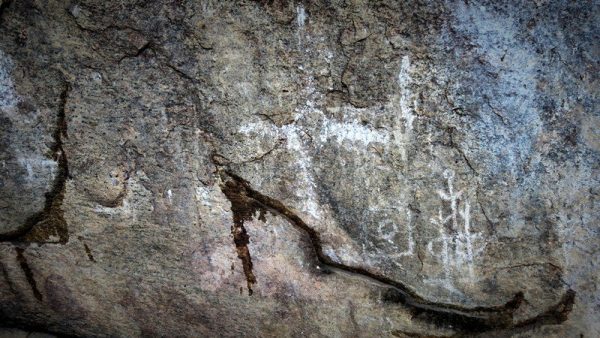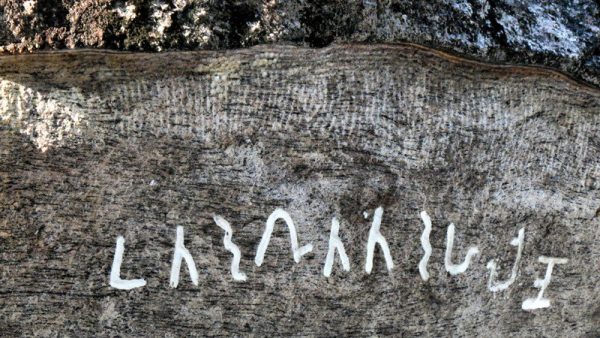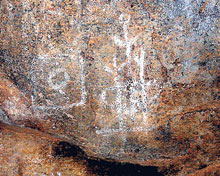General
Piyangala Chithralena – cave of frescoes in Ampara By Arundathie Abeysinghe




Piyangala cave paintings ( Chitra Lena) – cave paintings at Piyangala “chitra lena”


The main cave of the hermitage is the ‘Uttaraguptha Thera lena’ (meaning the cave of Uttaraguptha Thera in Sinhala) situated at the top of the mountain (along with 20 other caves) believed to have been utilized by a renowned *arhat known as Uttara Gupta Thera in the 1st century BC.
A stone paved path leads to the entrance of the monastery which has a 100 feet long (approximately 30 meters) walking path that has been utilized for meditation by ancient monks. There are moonstones in the caves that had been constructed in the 4th century BC. There is also a carved footprint of the Buddha in the premises.
Several *Brahmi inscriptions with details of the donations and donators have also been inscribed in these caves. Some caves at Piyangala have rock art of forest dwelling *vedda groups, the only caves with Veddah frescoes. According to historians, these caves had been inhabited by vedda groups when the monks had abandoned the Monastery. Two of these inscriptions are of great significance. According to *Professor Senarath Paranawithana, one of these inscriptions describes about offering of a cave by a relation of Queen Rajithaa, queen consort of *King Dutugemunu, whereas the other cave has been donated by a daughter of King Dutugemunu who was married to Parumaka Duta.


a cave at Piyangala
Spread over approximately 80 hectares (200 acres) of forest, Piyangala Forest Hermitage was the victim of a thirty- year old war, a rock quarry including a series of forest fires.According to scholars, the temple at Piyangala Forest Hermitage had been constructed in the 1st century BC by Queen Rajitha.
Located in the eastern section of *Rajagala mountain, Piyangala Chitralena came in to limelight in 2009 when an enormous rock quarry was on one side of the rock and the rock was blasted to construct the *Oluvil Harbor. The ancient cave with frescoes (Chithra Lena) has been partially damaged due to the blast. As an environment assessment had not been carried out, the extent of the damage to these ancient caves is unknown.
At present, the temple has been declared as an archaeological site by the Department of Archaeology.
Location: Approximately 18 kilometers from Uhana town in Ampara


Directions: A board of the Department of Archaeology located before the turn off to the Pulukunava Raja Maha Viharaya is the road to this majestic cave situated approximately 100 meters away from the road.
Image courtesy – amazinglanka.com & sundaytimes.lk
- Ampara – Located in the Eastern Province of Sri Lanka about 360 kilometers east of Colombo, Ampara is the main town of Ampara District.
- Arhat – According to Buddhism, an Arhat is one who has attained *Enlightenment gained insight into the true nature of existence and achieved *Nirvana.
- Brahmi inscriptions – The earliest writing system developed in India after the Indus script and considered as an influential writing system. All modern Indian scripts as well as several hundred scripts that are in South Asia, Southeast and East Asia are derived from Brahmi.
- Enlightenment – In Buddhism, Enlightenment is when a Buddhist finds the truth about life and stops being reborn as he/she has reached *Nirvana.
- King Dutugemunu – Also known as Duttagamini was born to a royal family in southern Sri Lanka. His parents were King Kavantissa and *Princess Vihara Maha Devi. Prince Dutugemunu became King Dutugemunu (164 BC – 140 BC). His brother was Prince Saddha Tissa.
- Nirvana – Refers to a release from the cycle of death and rebirth, the ultimate spiritual goal of Buddhism.
- Oluvil Harbour – A commercial and fishery harbor located in the Ampara District of the Eastern Province of Sri Lanka. The port was declared open on September1, 2013.
- Princess Viharamahadevi – She was the daughter of King Kelanitissa and the Queen consort of King Kawantissa who was known as Queen Viharamahadevi after marriage. Queen Viharamahadevi was the mother of King Dutugemunu and Prince Saddhatissa. According to legends, the innocent Princess sacrificed her life to the sea to stop waves which were flooding inland. But when the boat was drifted to the sea, the sea had become calm and the boat had drifted inland saving the Princess. King Kawantissa had been impressed by her bravery and got married to her.
- Professor Senarath Paranavitana (1896 – 1972) – Pioneering archeologist and renowned epigraphist of Sri Lanka, his works dominated Sri Lankan archaeology as well as history during the middle-part of the 20th century. In 1940, he assumed duties as the Commissioner of Archeology.
- Vedda – Also spelt as Veddah and referred to as “Wanniyaletto” are a minority indigenous group in Sri Lanka. They are considered as the aboriginal inhabitants prior to the 6th century BC. According to scholars, the term ‘Vedda’ is a Dravidian word and stems from the Tamil word ‘Vēdu’ meaning ‘hunting’. Veddas worship dead ancestors. Their religion is based on Animism, a belief that animals, plants and inanimate objects possess a spiritual essence, considered as non-human entities.
- Rajagala – magnificence of Sri Lanka’s prehistoric era – By Arundathie Abeysinghe








